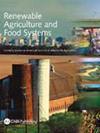Probabilistic simulation of phosphorus loss using the Vermont P-index: a bottom-up field to watershed approach
IF 2
3区 农林科学
Q2 AGRICULTURE, MULTIDISCIPLINARY
引用次数: 0
Abstract
Abstract Anthropogenic nutrient loading from land use, especially agriculture, is a major threat to waterbodies worldwide. Efforts to govern nutrient pollution are increasingly based on simulation modeling for research, evaluation, and regulation. This study develops a novel approach to simulate nutrient losses from agriculture applied to the Lake Champlain basin in the US state of Vermont. The Vermont Phosphorus-Index—a farm-based empirical model regularly used for site evaluation—is scaled up to the basin level with high-resolution geographic data and probabilistic estimation of unknown parameters and management practices. Results are comparable with analyses using more data and computationally intensive tools. Important insights into basin-wide management include: (1) nutrient-management planning can significantly reduce P losses in a livestock-agriculture-dominated watershed by re-distributing manure applications from areas of high loss to low loss; (2) hotspot identification from geographic data alone may be deeply complicated by high underlying heterogeneity of soil phosphorus; and (3) probabilistic modeling using simple, field-scale models is a potentially useful complement to complex watershed process models. Findings suggest that currently available best-management practices will likely be insufficient to reach reduction targets in the most impaired sub-watersheds. Reductions of agricultural land use and herd size, particularly in intensive dairy operations, may be necessary.利用佛蒙特p指数进行磷流失的概率模拟:自下而上的农田到流域方法
土地利用(尤其是农业)造成的人为养分负荷是全球水体面临的主要威胁。治理营养物污染的努力越来越多地基于模拟模型进行研究、评估和监管。本研究开发了一种新的方法来模拟美国佛蒙特州尚普兰湖流域的农业营养损失。佛蒙特州磷指数是一种基于农场的经验模型,经常用于现场评估,通过高分辨率地理数据和未知参数和管理实践的概率估计,将其扩展到流域水平。结果可与使用更多数据和计算密集型工具的分析相媲美。对全流域管理的重要见解包括:(1)营养管理规划可以通过将肥料从高损失区重新分配到低损失区,显著减少以畜牧业为主导的流域的磷肥损失;(2)由于土壤磷的潜在异质性较高,仅从地理数据识别热点可能会变得非常复杂;(3)使用简单的野外尺度模型进行概率建模是对复杂流域过程模型的潜在有益补充。调查结果表明,目前可用的最佳管理做法可能不足以在受损最严重的子流域实现减少目标。可能有必要减少农业用地和畜群规模,特别是在集约化乳品经营中。
本文章由计算机程序翻译,如有差异,请以英文原文为准。
求助全文
约1分钟内获得全文
求助全文
来源期刊

Renewable Agriculture and Food Systems
农林科学-农业综合
CiteScore
5.20
自引率
7.40%
发文量
39
审稿时长
>36 weeks
期刊介绍:
Renewable Agriculture and Food Systems (formerly American Journal of Alternative Agriculture) is a multi-disciplinary journal which focuses on the science that underpins economically, environmentally, and socially sustainable approaches to agriculture and food production. The journal publishes original research and review articles on the economic, ecological, and environmental impacts of agriculture; the effective use of renewable resources and biodiversity in agro-ecosystems; and the technological and sociological implications of sustainable food systems. It also contains a discussion forum, which presents lively discussions on new and provocative topics.
 求助内容:
求助内容: 应助结果提醒方式:
应助结果提醒方式:


